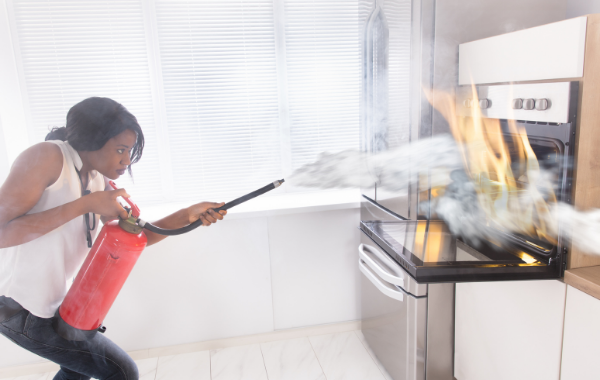
Fall is in full force and winter is slowly approaching.People are lighting pumpkin spice candles, turning on the heat, and decorating for the upcoming holidays (I’m guilty on all accounts).And with the colder temperatures, people will be staying indoors a lot more.
All of these actions actually influence the higher number of structural fires in the fall and winter, so let’s talk fire safety.Fire Protection Week is October 4-10 and it’s a great time to revisit some basic fire safety tips and practices.Cook with caution: This is actually the focus of Fire Prevention Week this year.
Young students in schools all over the nation will be seeing Sparky the dog and hearing his 2020 slogan, “Serve up Fire Safety in the Kitchen,” because unattended cooking is the leading cause of home fires! Don’t stray too far away from the kitchen when cooking.It’s easy to get distracted while something is simmering on the stovetop or baking in the oven, but try using a timer as a helpful reminder something is cooking.Also, consider keeping at least a three-foot radius around the stove as a “kid-free zone” to prevent accidental bumping of hot pots and pans.Heating the home: It reached 68 degrees in my home in Ohio yesterday, and I asked my husband if we could turn on the heat.
He’s a good and smart husband, so he did.When the heat goes on in your house, make sure to keep anything that can be combustible away from heating equipment, such as fireplaces, wood-burning stoves, and space heaters.We have baseboard heat in our house, so we also have to be cautious that pillows, blankets, curtains, and other flammable materials stays away from the heaters.
Also, have your heating equipment inspected annually by professionals to help prevent system malfunctions that could cause a fire.Safety equipment: Speaking of equipment, a big piece of fire safety and prevention is ensuring all the equipment is working properly.It is a good idea to test all smoke alarms monthly, change batteries annually, and replace the old alarms with newer models after 10 years.
If there is anyone in the household who is hard of hearing, there are smoke alarms available that have strobe lights to visually alert them of a fire.Also, have a working fire extinguisher that is visible, unobstructed, and in its designated location.Candlelight: Candles can make lovely decorations and really accent a home (and make it smell like pumpkin spice), but they can also be very dangerous.Keep candles in a sturdy holder so they won’t tip over easily, whether they’re in a jack-o-lantern, on the kitchen table, or being used as a light source in a power outage.
Keep hair and clothing away from the candle as you light it, and don’t burn a candle down to the very end.Electrical outlets: The fall and winter seasons are a time when most people begin decorating their homes.A safety tip to remember when it comes to decorations is to not plug too much into an extension cord or safety strip.
Big appliances should always be plugged directly into a wall outlet.Make sure electrical cords are not running under carpets or in front of doorways because they could also become a potential trip hazard.Fall and winter are beautiful seasons filled with holidays, good food, and cozy nights with the family.Don’t let a fire prevent you from spending this season with your family.
For more tips and fire prevention information, check out this inforgraphic and the National Fire Protection Association (NFPA) website.I hope you try using some of these fire prevention tips in your household.After all, the best protection against fire is prevention.
Share this For Kids by a Kid video with your children to help reinforce fire safety.Share this:FacebookTwitterLinkedInMoreEmailPrintLike this:
Publisher: Central Insurance Companies








